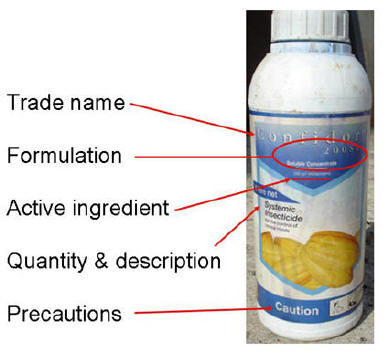Phil Peters
Adams County Master Gardener
 Of course you want to garden as organically as possible. Avoid chemicals in the garden. We hear this call all the time.
Reducing our dependence on chemicals is essential if we are to protect the predators and pollinators in our gardens, as well as ourselves and our children. But, try as we might, there come times when a judicious use of
chemical pesticides is the most effective way to protect our garden plants. As a gardener who is attuned to the environment, you naturally want to make a wise decision on whether to use such a pesticide, which one to use,
and when to use it.
Of course you want to garden as organically as possible. Avoid chemicals in the garden. We hear this call all the time.
Reducing our dependence on chemicals is essential if we are to protect the predators and pollinators in our gardens, as well as ourselves and our children. But, try as we might, there come times when a judicious use of
chemical pesticides is the most effective way to protect our garden plants. As a gardener who is attuned to the environment, you naturally want to make a wise decision on whether to use such a pesticide, which one to use,
and when to use it.
Always choose the correct pesticide for the pest you want to control. Apply it carefully and properly. This will ensure that you donít use an excessive amount or harm yourself or the environment. The
key to choosing the correct pesticide and using it responsibly is the product label.
Iíll bet you didnít know that the label on a pesticide product is a legal document. It is a binding agreement between the purchaser of the pesticide and the manufacturer that the purchaser will use
the product according to the instructions on the label and only in that manner. There are fines for misuse and they can be steep.
So letís take a look at what information is on that label and what it tells you.
 If you pick up many of the products on the store shelf, you will probably be surprised by the length of the label and the amount of information it contains. It is a veritable book in very small type.
But read it, you must.
If you pick up many of the products on the store shelf, you will probably be surprised by the length of the label and the amount of information it contains. It is a veritable book in very small type.
But read it, you must.
The product name is the first thing that will strike your eye. Beneath the product name will be the kind of pesticide it is: insecticide (controls insects), fungicide (for fungus), herbicide (kills
grasses), etc. Always buy the correct product for the pest you need to control. A miticide (kills mites) will not work on insects, and vice versa. Mites are arachnids (i.e., spider, eight legs) and not insects (six legs).
You will also see various registration numbers and the manufacturerís name and address. These identify the maker and the factory where the product was produced.
Then there will be a list of the active ingredients, the chemical name, common name of the chemical and the inactive ingredients that serve as carriers of the chemicals. When you compare the different
products on the shelf, match the active ingredients and the amount delivered in the recommended application. This way you are comparing apples to apples.
All labels must contain the words Keep out of Reach of Children. Below this will be the signal word. This is a word that tells you how toxic the product is. This signal word must be in English and
Spanish. The most powerful is Danger Poison with a skull and crossbones symbol Peligro. This is a restricted pesticide and will not be on the hardware shelf. Indeed you can only purchase it if you have professional
certification.
More likely the container will say simply Danger. This is the most severe notice on the average pesticide. The chemical can cause severe eye damage or skin irritation. Next down the toxicity ladder is
Warning Aviso. This product causes moderate eye or skin irritation. The least dangerous is Caution (same in Spanish) indicates that if the product is taken orally, inhaled or gotten on the skin, it will cause slight eye or
skin irritation.
Near these words will be statements of treatment and a note to a physician. If, heaven forbid, the product is mishandled or is ingested accidentally, this part of the label tells you what steps to
take. Note: if you have to take the person, or yourself, to the hospital, Take the label with you. It will save the emergency personnel valuable time in treating the patient since they will know exactly which chemicals are
involved.
You will also find valuable information on using the product in an environmentally safe manner, how to mix, apply, store and dispose of the product. These are instructions that the user must follow to
get the most effective use out of the chemical. Donít exceed the dosage called for.
The biggest part of the label is the part that contains the list of the insects or pests controlled and the plants you can use the product on. Make sure that the product actually controls the specific
insect or fungus that is causing you problems. (Take a sample to your local Extension Office if you need help identifying an insect, etc.)
Another important part of the label tells what vegetable/fruit crops you can apply the product to and how long after application you must wait before you harvest the crop. Make sure you follow these
directions.
Read the label. It makes sense; it saves money; it is part of being a responsible gardener. Happy gardening!
Read other articles on lawn care & weed control
Read other articles by Phillip Peters